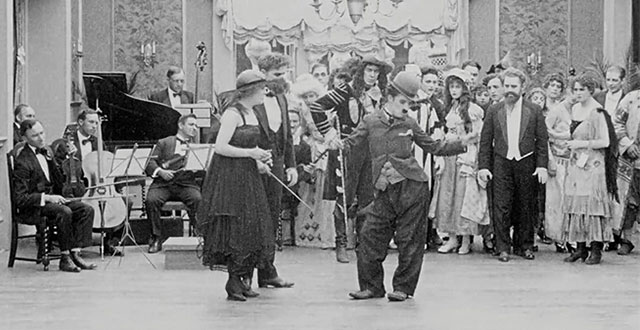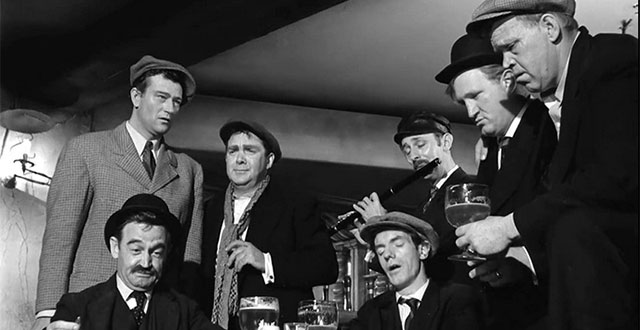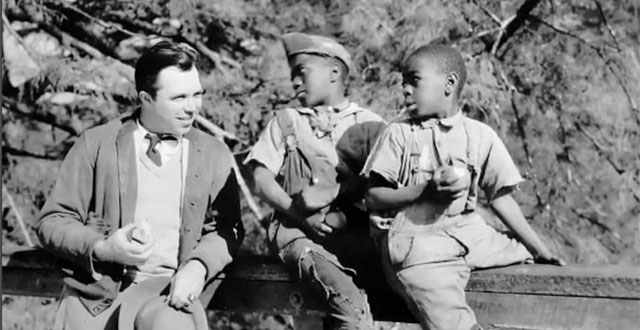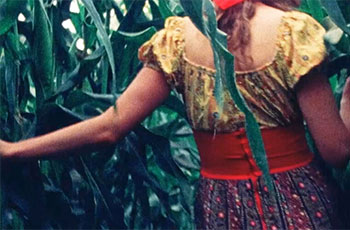News
NOTES ON FILM & RESTORATION
In 1998, the Cineteca di Bologna and their laboratory L’Immagine Ritrovata restored Charles Chaplin’s The Kid, and that was the beginning of a great, essential undertaking called The Chaplin Project, undertaken in partnership with the Paris-based Association Chaplin. The goal is to restore and preserve all of Chaplin’s films and outtakes and to catalogue and digitize all of his papers. Thus far, the Cineteca has restored over 60 of Chaplin’s films. The Film Foundation has participated in four of those restorations—one title from Essanay (A Night in the Show) and three from the Mutual period (The Count, The Pawnshop and The Cure—TFF also collaborated on an earlier photochemical restoration of that film and The Floorwalker with MoMA). The Cineteca has also made vast portions of his archives available online (link below) and published Chaplin-related DVDs (including the great Kevin Brownlow’s amazing 1983 documentary Unknown Chaplin) and books, including his 1948 novella Footlights (precursor of Limelight) and Chaplin scholar and biographer David Robinson’s book about Chaplin’s unmade final film, The Freak.
About ten years ago, there was a screening of The Gold Rush at The New York Film Festival with a great live score (following Chaplin’s original) conducted by the estimable Timothy Brock. I decided to go, figuring I’d have a good time revisiting the film. I found myself absolutely entranced. After the film was over, the writer Larry Gross and I were talking and he put it very simply: “Chaplin is just great, isn’t he?” I just nodded in amazement. I realize now that I’ve had the same experience almost every time I’ve gone back to a Chaplin film. You think you know them, that nothing could be more familiar. You think you know the gags, the cuts, even the moves. And then, suddenly, something jolts you, the tiniest detail, and it’s like you’re seeing the film for the first time again. Stanley Kubrick said it perfectly: “If something is really happening on the screen, it isn’t crucial how it’s shot. Chaplin had such a simple cinematic style that it was almost like I Love Lucy, but you were always hypnotized by what was going on, unaware of the essentially non-cinematic style. He frequently used cheap sets, routine lighting and so forth, but he made great films. His films will probably last longer than anyone else’s.”
- Kent Jones
Follow us on Instagram, and Twitter!
http://www.charliechaplinarchive.org/en
https://www.youtube.com/watch?v=KI6qtN8Huv0
https://www.youtube.com/watch?v=7GS4wFVdPEo
THE COUNT (1916, d. Charlie Chaplin)
Restored by Cineteca di Bologna at L'Immagine Ritrovata, in collaboration with Lobster Films and Film Preservation Associates. Restoration funding provided by The Film Foundation, the Hobson/Lucas Family Foundation and the Material World Charitable Foundation.
THE CURE (1917, d. Charlie Chaplin)
Photochemical restoration: Preserved by The Museum of Modern Art with funding provided by The Film Foundation.
Digital restoration: Restored Cineteca di Bologna at L'Immagine Ritrovata, in collaboration with Lobster Films and Film Preservation Associates. Restoration funding provided by The Film Foundation, the Hobson/Lucas Family Foundation and the Material World Foundation.
THE FLOORWALKER (1916, d. Charlie Chaplin)
Preserved by The Museum of Modern Art with funding provided by The Film Foundation.
A NIGHT IN THE SHOW (1915, d. Charlie Chaplin)
Restored by Cineteca di Bologna at L’Immagine Ritrovata laboratory, in collaboration with Lobster Films and Film Preservation Associates. Restoration funded by The Film Foundation, the Hobson/Lucas Family Foundation and the Material World Charitable Foundation.
THE PAWNSHOP (1916, d. Charlie Chaplin)
Restored Cineteca di Bologna at L'Immagine Ritrovata, in collaboration with Lobster Films and Film Preservation Associates. Restoration funding provided by The Film Foundation, the Hobson/Lucas Family Foundation and the Material World Charitable Foundation.
NOTES ON FILM & RESTORATION
From time to time, it has been fashionable to downgrade, dismiss, attack and even outright condemn John Ford. His films are too slow and lace-curtain Irish. He trades in myth and glorifies the military. He’s a racist. He’s a fascist. And so on. You don’t really hear sweeping judgments of Ford anymore for the simple reason that fewer and fewer people know who he was or have seen his films. Many years ago, I remember indulging in such rhetoric myself for a brief moment, my love for several of Ford’s films aside. It was my old friend, the leftwing filmmaker John Gianvito, who gently re-oriented my thinking.
The rhetoric about John Ford is several worlds away from the work itself. But it is best to put it simply: if you’re drawn to the art of cinema, then you will either come to or return to John Ford’s work. Ford is as fundamental as Hitchcock or Rossellini. His greatest films—there are many of them—have a concentrated energy that makes almost everything around them seem laborious in comparison. They certainly do reflect an earlier moment in American history, albeit with far greater complexity and circumspection than is often acknowledged.
The Film Foundation has participated in the restorations of 12 Ford films, in collaboration with MoMA, UCLA and the Academy Film Archive. The Long Voyage Home is one of the most recent. Like several of Ford’s films, it was made independently, with the producer Walter Wanger (Ford and Merian C. Cooper set up a new company for the project, Argosy). It is based on four of Eugene O’Neill’s pre-WWI sea plays—The Moon of the Caribees, Bound East for Cardiff, The Zone and The Long Voyage Home—updated by Ford and his screenwriter Dudley Nichols to reflect contemporary conditions for merchant seamen, right before WWII. Ford and his DP Gregg Toland took light, shadow and the play of visual textures to an almost hair-raising level. Joseph McBride beautifully describes Ford’s cinematic poem of deep, sustained longing in his essential biography: “An almost abstract exercise in the creation of a doom-laden mood with deep pools of light and shadow, filmed largely on cramped studio sets, this adaptation of four sea-plays by Eugene O’Neill is one of the most avant garde films ever made in Hollywood.” O’Neill himself loved the film, and he reportedly had a 16mm print made for himself, which he showed often to friends and guests.
If anyone reading this is just starting to get interested in the cinema, I will come out and say that no matter how odd they might seem at first glance, no matter how distant from contemporary image-making, you owe it to yourself to watch the work of John Ford, just as Orson Welles and Ingmar Bergman and Jean-Marie Straub & Danielle Huillet and Martin Scorsese and so many others did before you. You might be tempted to dismiss him out of hand, but you’ll be doing it at your own peril. To paraphrase Peter Brook on Shakespeare, John Ford is always ahead of us.
- Kent Jones
Follow us on Instagram, and Twitter!
THE LONG VOYAGE HOME (1940, d. John Ford)
Restored by the UCLA Film & Television Archive. Restoration funding provided by the Hollywood Foreign Press Association and The Film Foundation.
https://www.thenedscottarchive.com/hollywood/films/the-long-voyage-home.html
https://www.youtube.com/watch?v=2P2fY75Qlxs
https://www.youtube.com/watch?v=YJAMf21uNH4
https://www.youtube.com/watch?v=DfUw4SN1Nig
NOTES ON FILM & RESTORATION
He Walked by Night is commonly cited as a “noir” classic, but when it was released in 1948 it was one of the more highly regarded examples of the semi-documentary (or “docudrama”) subgenre that had its first glimmers at the end of the 30s (in Warner Brothers films like Confessions of a Nazi Spy) and flourished in the postwar years—Henry Hathaway’s House on 92nd Street was something of a starting point. He Walked by Night was based on the notorious case of Erwin Walker, who worked as a radio operator and a dispatcher for the Glendale police before he was drafted and placed in the Signal Corps. He was stationed in the Philippines, and a horrifying incident resulting in the slaughter of many men in his command by Japanese paratroopers left him shattered. When he returned to LA, he started with burglary, stealing tools, weapons, radio equipment, film projectors, recording equipment and cameras, as well as pistols, revolvers and a Thompson sub-machine gun. He fitted out a rented garage as a private studio where he planned to build a radar gun that would melt metal and give him leverage with the government to increase the pay rate for conscripted soldiers and thus render all wars too ruinously expensive to undertake. When he tried to sell some of his stolen equipment to a sound engineer, he got into a gunfight, which left everyone wounded. Walker escaped through a network of storm drains and treated his own wounds. After another attempted holdup, Walker shot and killed a cop, who lived long enough to identify him.
Walker was apprehended and arrested after a violent struggle, but in the movie Richard Basehart’s Roy Morgan is shot and killed in the storm drain tunnels. It’s interesting to consider what was retained from the true story and what was left out—namely, everything related to Walker’s war experience. Dramatically speaking, what was left was an enigma, made quite compelling by the ingeniousness and absolute commitment of Richard Basehart to the role and the film’s severely concentrated visual style. He Walked by Night is credited to Alfred L. Werker, but every cinema lover knows that Anthony Mann took over the film at some indeterminate point. It’s certainly not difficult to detect Mann’s presence, but the overall visual unity comes from the DP, John Alton, beloved by directors like Mann (they made six films together), Vincente Minnelli (who specifically wanted and got Alton for the American in Paris ballet) and Richard Brooks, and despised by old-line studio technicians who resented his speed and his sometimes outrageous lighting plans. The visual power of He Walked by Night is so great that it shone through years of substandard public domain prints and video transfers. It was beautifully restored by TFF and UCLA in 2016, and can now be appreciated in all its splendor.
Two postscripts. 1 - Walker was found mentally competent, tried, convicted, sentenced to death, and then he tried to hang himself. His execution was indefinitely postponed, he became a model prisoner, he escaped and was re-captured, and he was granted parole in 1974, after which he changed his name, worked as a chemist, and died quietly in 1982. 2 – Jack Webb, who played a forensics expert in the film, was inspired by the project (specifically, by his meeting with LAPD officer and technical advisor Marty Wynn) to create Dragnet.
- Kent Jones
Follow us on Instagram, and Twitter!
HE WALKED BY NIGHT (1948, dirs. Alfred Werker and Anthony Mann)
Restored by the UCLA Film & Television Archive and The Film Foundation, with funding provided by the Hobson/Lucas Family Foundation.
NOTES ON FILM & RESTORATION
When Galveston-born King Vidor, one of the most successful directors in Hollywood, went to MGM just after the dawn of sound with the idea of making an all-black musical, he was immediately shot down. He went back to Nicholas Schenck, Chairman of the Board of MGM’s parent company, with several different approaches, and the answer was always no. It was a matter of economics: southern exhibitors would never open the film, which meant that it could never make a profit. Vidor followed Schenck’s logic and told him that he would contribute his $100,000 salary to the cost of production. Schenck took him up on his offer. Vidor cast the principal roles in Chicago. Daniel Haynes, who played the sharecropper-turned Baptist minister Zeke, was a theatre actor and, at the time, Jules Bledsoe’s understudy in Show Boat (speaking of Show Boat, Vidor had wanted Paul Robeson for the role but he was unavailable). Nina Mae McKinney, who Vidor spotted in the Broadway show Blackbirds, was cast as Zeke’s “seductress,” Chick. The great blues singer Victoria Spivey, in her one film role, played Zeke’s devoted wife Missy Rose. (Side note: that’s Spivey sitting next to a very young Bob Dylan on the back cover of New Morning.) Another important collaborator was Eva Jessye, a choral conductor who would later work with George Gershwin as musical director on Porgy and Bess. Jessye, who curated, arranged, rehearsed, directed and conducted the spirituals and traditional songs for the film, later wrote a three-part piece for the Baltimore Afro American called “The Truth about Hallelujah.” The piece went into considerable detail about the film’s production and delved into the issues that are front and center today, and that too many current writers mistakenly think they’re the first to discover. On the matter of Vidor’s representation of Black American life in the south, there’s as little doubt about the film’s paternalism as there is about the film’s vibrant energy and beauty (not to mention its technical ingenuity: the sound trucks Vidor had planned to use for his location shooting never showed up, so he had to work rhythmically, using a metronome to time his shots as he had for the advance in The Big Parade). As for paternalism, it was built into the culture, and hence into Hollywood production and its complicated and ever-shifting relationship with American society (at its very worst, it resulted in Louis B. Mayer’s beloved Andy Hardy series). Warner Brothers has included an elaborate disclaimer on its previous DVD edition which, as Kristin Thompson points out, “essentially brands Hallelujah as a racist film.” To say that this oversimplifies matters is to put it way too mildly. Is it possible to think critically about Hallelujah and admire it at the same time? W.E.B. DuBois did exactly that when he reviewed the film in The Crisis: “Hallelujah is a great drama. It touches the religion of a deeply superstitious people who took refuge from physical disaster in spiritual tradition, hope and phantasy…It is the sense of real life without the exaggerated farce and horseplay which most managers regard as inseparable from Negro character, that marks Hallelujah as epoch-making.” Would anyone dream of making the same film today? Of course not, and that includes King Vidor, if he were still with us.
The Library of Congress’ beautiful restoration of Hallelujah, which we touched on this past August, recently opened Film Forum’s tribute to McKinney, programmed by Bruce Goldstein in consultation with Donald Bogle. Bruce’s name has also come up often in these posts, and with good reason. Restorations are meaningless without the curators who program them, and Bruce is a true hero in his field, with the temperament of a true artist. He’s one of the people who keeps film culture as we know it alive and thriving.
- Kent Jones
Follow us on Instagram, and Twitter!
HALLELUJAH (1929, d. King Vidor)
Restored by the Library of Congress and The Film Foundation. Funding provided by the Hobson/Lucas Family Foundation.




